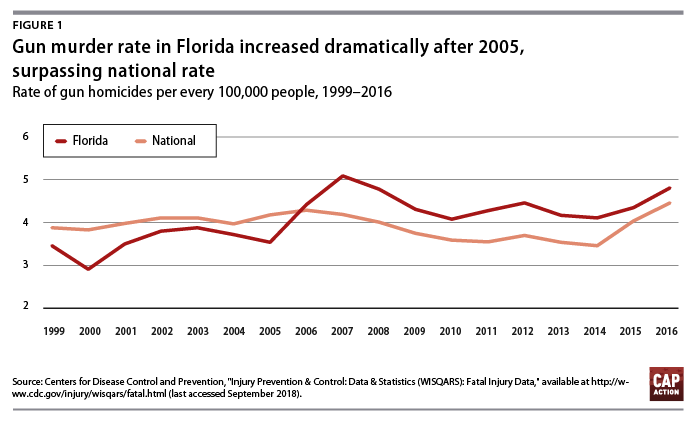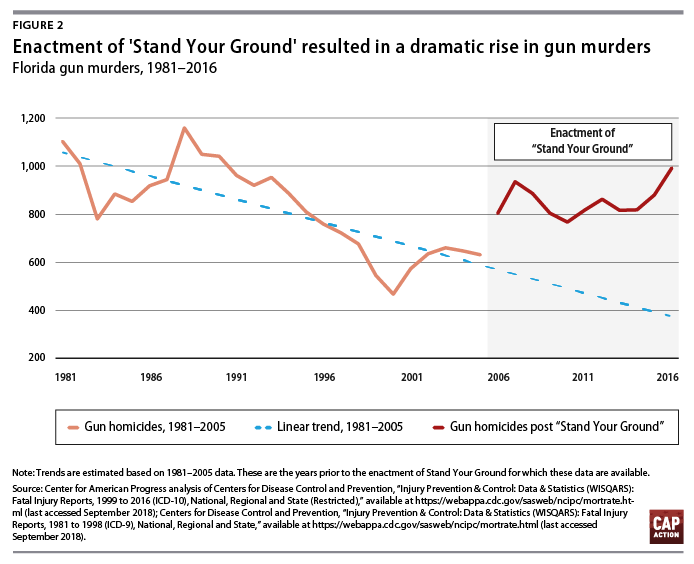In recent years, gun violence in Florida has reached a nearly two-decade high. In addition to the devastating mass shootings at Pulse nightclub, Marjory Stoneman Douglas High School, the Fort Lauderdale airport, and a Jacksonville video game tournament, gun violence affects communities across the state every day. In fact, from 1999 through 2016, the overall rate of gun-related deaths in Florida—including homicides, suicides, and accidental shootings—has increased 20 percent.
This increase is largely driven by a significant rise in gun-related murders in Florida. Prior to 2006, Florida’s gun murder rate was below the national rate; however, since 2006, the gun murder rate in the state has risen dramatically. In 2016, the most recent year for which data are available, the gun murder rate in Florida was 8 percent higher than the national rate. At the same time, from 1999 through 2016, the nongun murder rate in Florida declined 45 percent. This increase in gun murders in Florida was not part of a national trend. After 2006, the national gun murder rates slightly declined—until a recent spike in 2016—indicating that the dramatic rise in Florida’s gun homicides was caused by something that is unique to the state.*

It is often difficult to ascertain the precise cause of an increase in a particular category of violent crime. However, in the case of Florida and its skyrocketing gun murder rate, researchers have been able to identify a clear culprit: the 2005 enactment of an expansive self-defense law commonly referred to as “stand your ground.”
Stand your ground laws increase homicide rates in Florida
The new law—which was the first of its kind in the nation—dramatically expanded the conventional approach to self-defense, empowering individuals to use lethal force even when safe retreat from the situation is possible or when lesser, nonlethal force would suffice. Most notably, stand your ground eliminated an individual’s duty to retreat from a dangerous situation before resorting to lethal force; removed any legal incentive for an individual to try to de-escalate or escape an encounter; and shifted lethal force from a last resort option to a first move. The law went even further by explicitly immunizing people who invoke it from criminal prosecution and civil liability—in many cases, preventing individuals who killed another person and claimed self-defense from even being arrested or charged with a crime.
A team of researchers examined the homicide rate in Florida before and after stand your ground and, in a study published in the Journal of the American Medical Association, found that the enactment of this law was associated with a dramatic increase in both overall homicides and gun-related homicides in the state. After controlling for other factors and comparing the homicide rates with trends in other states, the researchers determined that the monthly gun murder rate in the state increased 31.6 percent after the law was enacted, while the monthly overall murder rate increased 24.4 percent.
Using this research, CAP Action calculated the number of individuals murdered with a gun in Florida who would not have been killed in this manner had stand your ground never been enacted and had previous trends continued. The analysis finds that, since 2006, the lives of approximately 4,200 individuals in Florida who were murdered with a gun may have been saved had this law not been enacted and that earlier trend continued.**

Stand your ground convictions reveal racial bias
Not only has Florida’s stand your ground law increased the state’s gun-related murders, but it has also been proven to have a racially disparate impact as applied. Researchers analyzed stand your ground defenses used in Florida from 2005 through 2013 and found these defenses were far more likely to be successful if the victim was black, Hispanic, or another race or ethnicity other than white. Specifically, the researchers found that defendants in Florida using the stand your ground defense were two times more likely to be convicted if the victim was white, concluding that “SYG legislation in Florida has a quantifiable racial bias that reveals a leniency in convictions if the victim is non-White, which provides evidence towards unequal treatment under the law.”
These findings are consistent with previous research on the impact of stand your ground laws indicating that in states that have enacted these laws, 35.9 percent of shootings of black victims by white perpetrators were deemed justified, while only 3.4 percent of cases with black perpetrators and white victims had the same result.
The contentious debate continues
Even in the face of this mounting evidence that stand your ground laws are harmful, Florida’s Republican leadership in the state Legislature doubled down on the law in 2017, amending it to be even more extreme. This new element makes it even more difficult to mount a prosecution when an individual seeks immunity under the stand your ground law; it requires prosecutors to prove that use of lethal force was unlawful by clear and convincing evidence at the pretrial stage, rather than requiring a defendant to prove the elements of this defense.
Since its enactment, stand your ground has continued to be a controversial topic in Florida. Beginning with the murder of Trayvon Martin in 2012, each new high-profile case in which stand your ground is invoked reignites the debate. Most recently, the July 2018 shooting death of Markeis McGlockton in Clearwater and the initial refusal of police to arrest the perpetrator, Michael Drejka, led to another round of public debate about the advisability of this law.
This debate rages on in Florida’s gubernatorial race, as the current candidates present a stark contrast on the issue. Republican nominee and former Rep. Ron DeSantis (R) has repeatedly expressed his support for the state’s stand your ground law, stating that repealing the law “would impose a duty to retreat upon law-abiding Floridians, which would tip the scales in favor of criminals.” In contrast, Democratic nominee and current Tallahassee Mayor Andrew Gillum has expressed substantial concern about the impact of stand your ground on safety in Florida, stating that the law “has created a state of emergency in Florida” and that if elected governor, he would issue an executive order suspending the law.
Conclusion
As the first state in the nation to enact an expansive stand your ground self-defense law, Florida set a trend in state legislatures that has resulted in nearly half of all states enacting a similar law. But with more than a decade of data now available to assess the impact of this law in the state, Floridians have ample information to determine whether this law has proven beneficial to the safety of all communities statewide, or whether it is a failed experiment in need of immediate repeal.
Chelsea Parsons is the vice president of Gun Violence Prevention at the Center for American Progress Action Fund. Eugenio Weigend is the associate director for Gun Violence Prevention at the Center.
*Authors’ note: These data are based on a CAP Action analysis of data from the Centers for Disease Control and Prevention (CDC), “Fatal Injury Reports, National, Regional and State, 1981 – 2016,” available at https://webappa.cdc.gov/sasweb/ncipc/mortrate.html (last accessed September 2018). This analysis was based on crude rates. However, similar trends and results are observed when using age-adjusted rates.
**Authors’ note: This projection is based on a CAP Action analysis of data from the CDC, “Fatal Injury Reports, National, Regional and State, 1981 – 2016.” For this analysis, the authors used data on Florida’s annual gun homicides from 1981 to 2005 to estimate trends and calculate projected gun homicides in Florida from 2006 to 2016 had the previous 1981 to 2005 trend continued. They then compared those estimated figures with the real annual number of homicides in Florida from 2006 to 2016. These data come from two CDC data sets: one that includes homicide data in Florida from 1981 to 1998 and the second that includes homicide data in Florida from 1999 to 2016. The authors acknowledge that the CDC suggests using caution when merging these two data sets, as the categories of causes of death are slightly different. However, studies have shown that changes in the categorization of suicide and homicides across the two data sets do not alter trends and that the two data sets are comparable for analyzing homicides. See Robert N. Anderson and others, “Comparability of Cause of Death Between ICD-9 and ICD-10: Preliminary Estimates” (Washington: Centers for Disease Control and Prevention, 2001), available at https://www.cdc.gov/nchs/data/nvsr/nvsr49/nvsr49_02.pdf.